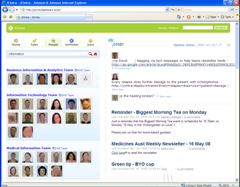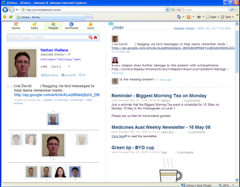

In February 2008, Janssen-Cilag Australia & New Zealand launched an internal microblogging platform called Jitter. Combined with our intranet’s people search capabilities, this formed an interesting enterprise hybrid of Facebook & Twitter style capabilities. This People Search with Jitter solution received Highly Commended in the 2008 Intranet Innovation Awards.
While our intranet wiki JCintra continues to be highly successful, we wanted to keep building our culture of collaboration by capturing and highlighting the flow of ideas. We also wanted to make it easier for our field force to participate and collaborate.
This post is an overview of our approach and outlines some of the lessons learned for others to consider as part of their journey.
This is the home page of the People Search component. Note the simple search box, followed by a list of recent/common searches and then a random face from the organisation.
On the right hand side you can see Jitter posts
integrated with the main site news feed. The last 3 posts are shown as a group,
and are injected into the news feed based on the latest post timestamp of the
news / Jitters.
Searching for a name (e.g. Nathan) shows results from first or last name matches. This quick view allows immediate use of the telephone numbers etc, and incorporates information from our local company system (Juice) and other operating companies through integration with the Outlook Corporate Directory they populate.
Search results are immediate (no Enter click
required) and use an AJAX component to prevent the need for full intranet page
refresh.
Users may choose to search for a team name (e.g. Information), which returns a picture wall of faces from matching teams.
Note that team and
individual results may be mixed together depending on the search term and
matches.
Simple page displaying all information for Nathan Wallace. The latest Jitter post is integrated as a status message.
The organisational
hierarchy is displayed, including peers, direct reports and his manager.
Clicking on those faces navigates the hierarchy. Green arrows show if a team is
present under that person.
SMS sending is integrated into the People Search. Messages can be addressed to individuals or entire teams.
If the sender has a mobile, the message appears to have come from their number. If not, there is no reply number, but instead a short text based name is shown on the recipients phone as the sender.
SMS costs are billed to the senders cost centre through the
Juice system.
Users can post to Jitter by clicking “Update status” in the Jitter section of the news feed, clicking “update” in the Jitter section of their People Search profile or by sending a text message to the designated mobile phone number.
Posting is done inline, fast to complete and published
immediately. Note that SMS following is also available in the system for real
time notification of new posts.
An archive of previous Jitter posts is available for
browsing.
So far, 59 different people have contributed a total of 306 posts to Jitter. We’re excited that about 17% of people have tried posting, but disappointed that posting remains so infrequent and experimental. Here are some examples:
Jitter has settled into a pattern as our informal news channel. It’s used for public congratulations, for sharing links and for short news flashes. This is a communication need that is infrequent, but not served by email (too intrusive) or JCintra news (too formal).
As a comparison, our SMS message sending tool has seen 104 users send 1852 messages to 5162 recipients. It is commonly used for announcements to the field force and individual messages from office based assistants to travelling executives. Usage has continued to grow each quarter since it was launched.
The flow of news on JCintra has been hugely successful and filled a natural need for the organisation. But Jitter wasn’t responding to a need, it tried to create demand. Open collaboration and idea sharing are common organisational goals, but that doesn’t mean there is latent demand among the people of the business for the tools that enable it. With any new organisational capability, always stay focused on end users and helping them to solve a problem.
While Jitter is a highly flexible tool that people are already using for a wide range of purposes, we didn’t do enough to position this new communication medium or to demonstrate the business value. People didn’t know how to use this new tool. Some feedback was negative, but overwhelmingly people asked “What do I post to it?”, “What’s the business value?”. Without clear answers, people just waited to see what others would do.
People have no idea what Twitter is. People have no idea what microblogging is. Most people don’t know what wiki’s, blogs or social networks are either. When explaining Jitter, one user was even worried that this meant that all the SMS text messages they sent to anyone would now be published on the Intranet. These technologies are natural and well known to people like us, but for the vast majority of people in the world they are new, confusing and weird. Remember to design your solutions and train people as though your mum is the key user!
Microblogging is particularly difficult to position as a business tool since it’s so hard to say anything worthwhile in so few characters. For an organisation starting the journey of sharing ideas and thoughts, blogging may be an easier starting point. Posts can be more serious and business like. Blogs are better known, and at worst look more like normal web pages. Authors can craft and position their entries to meet the political challenges and communication realities of the enterprise. Even if your organisation is ready for fast thoughts and short posts, authors can evolve towards really short blog entries.
In a recent post on microblogging in the enterprise Ross Dawson said “It’s a learning process. We must discover what a whole array of new communication technologies allow us to do as organizations. We don’t know yet. But we do know that they might make a massive difference to how effective we can be. So those who are the first to work it out will be ahead. No doubt about it.”.
At Janssen-Cilag, we’re a step or two closer to working it out.